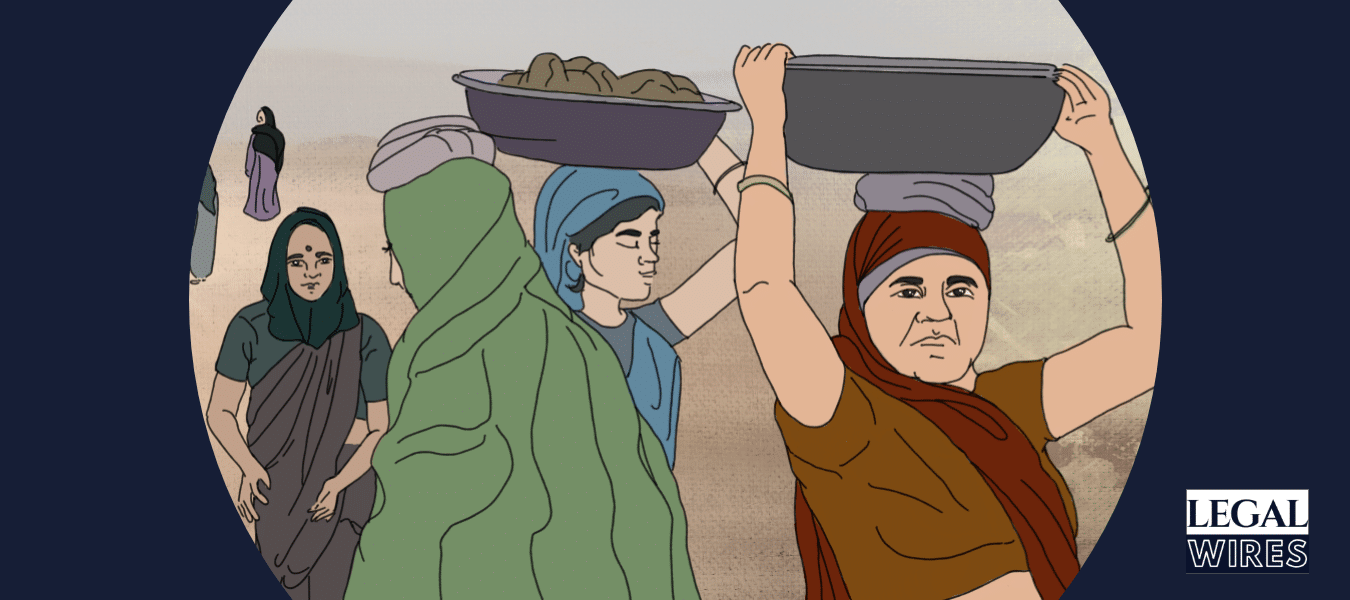The objective of the Act is to provide for the enhancement of livelihood security of the households in rural areas of the country by providing at least one hundred days of guaranteed wage employment in every financial year to every household whose adult members volunteer to do unskilled manual work

AI that prepares briefs and compliance checklists
Mahatma Gandhi National Rural Employment Guarantee Act, 2005 is one of the world’s largest poverty alleviation programs in the world undertaken by the Government of India. It’s the result of the efforts of many social activists and economists, notable among them is Dr. Jean Dreze, a Belgian India-based economist. The objective of the Act is to provide for the enhancement of livelihood security of the households in rural areas of the country by providing at least one hundred days of guaranteed wage employment in every financial year to every household whose adult members volunteer to do unskilled manual work and for matters connected therewith or incidental thereto.[1] The programme is humongous in terms of its reach as well as the scale of resources. It is demand driven and does not specifically target people belonging to a certain income level or social background.
This Act empowers the workers by recognizing employment as a legal right and enabling them to be active subjects of their own development. Through its enactment, it set the tone for a ‘rights-based development’ model in the country. These rights are in turn safeguarded through provisions mandating transparency, accountability and social audits. The Act fosters conditions for inclusive growth ranging from basic wage security and recharging rural economy to a transformative empowerment process of democracy.[2]
It was formally launched on 2nd February, 2006 by Dr. Manmohan Singh, the then Prime Minister at Bandlepalle Gram Panchayth, Narpala Mandala, Anantapur district of Andhra Pradesh. The country’s most backward two hundred districts were selected for the phase I. Later, it was extended to another 130 districts in 2007-08 and from April 2008 onwards it has been expanded to include all the 615 districts of the country. Since its inception the program has benefited over 21 crore rural households.[3]
Important Features of the Act are as follow:
- Creation of durable assets and strengthening the livelihood resource base of the rural poor.[4]
- Training and upgradation of the skills of unskilled laborers.
- All adult members of a rural household willing to do unskilled manual work have the right to demand employment.[5] An application for registration has to be filed with the Gram Panchayat by such households.[6]
- Post verification, the Gram Panchayat will issue a Job Card with photographs of all the adult members of the household willing to work under the programme. The Job Card must remain in the custody of the household.[7]
- Job Cardholder can apply for work to the Gram Panchayat which will issue him/her a dated receipt of the work application. Employment will be provided by the Gram Panchayat within 15 days of work application, failing which unemployment allowance will be paid.[8]
- Work should ordinarily be provided within 5 km radius of the village. In case work is provided beyond 5 km, but has to be within the Block, extra wages of 10% are payable to meet additional transportation and living expenses.[9]
- At least one-third beneficiaries shall be women who have registered and requested work under the scheme.[10]
- In case the number of children below the age of six years accompanying the women working at any site is five or more, provisions shall be made to depute one women worker to look after such children and she shall be paid the statutory minimum wage.[11]
- A proportion of the wages, not exceeding 5 percent, may be deducted as a contribution to welfare schemes organized for the benefit of laborers employed under the program, such as health insurance, accident insurance, survivor benefits, maternity benefits, and social security schemes.[12]
- Employment is to be provided at the minimum wage rate specified by the government. Disbursement of wages has to be done weekly basis and not beyond a fortnight.[13]
- Wages are to be paid according to the Minimum Wages Act 1948 for agricultural laborers in the State, unless the Centre notifies a wage rate which will not be less than Rs. 60/ per day.[14] Equal wages will be provided to both men and women.[15] It will be either paid in cash, or in kind, or both, provided that at least one-fourth of the wages shall be paid in cash.[16]
- A ratio of 60:40 for wage and material costs should be maintained at the Gram Panchayat level.[17] No contractors or labor-displacing machinery are to be used in the execution of work.[18]
- Panchayati Raj Institutions will have a principal role in planning, monitoring, and implementation.[19]
- Social Audit has to be done by the Gram Sabha.
The legislation provides an incentive to the States to provide employment, as 100 per cent of the unskilled labour cost and 75% of the material cost of the programme is borne by the Centre. Similarly, there is a disincentive to the States for failing to provide work on time because then they would have to bear the cost of the unemployment allowance. One of the key elements of the Act is the social audit and accountability measures. The Central Employment Guarantee Council (CEGC) is required to prepare an Annual Report on the outcomes of MGNREGA to be presented by the Central Government to both the Houses of Parliament.[20] On a similar vein, annual reports are to be prepared by State Employment Guarantee Councils (SEGC) to be presented to State Legislatures by the State Governments, facilitating oversight by elected representatives.[21]
Apart from generating employment, the Act also aims at creating productive assets, empowering women, reviving local economy, strengthening grass-root institutions, reducing distress migration and protecting environment to name a few. Over the years, the Act has been creating a silent revolution in the rural India. The Act has helped workers and civil society organisations galvanise action and mobilise around work-related issues. Several excellent examples of these exist, indeed there are too many to name. It is hard to think of another social welfare programme that admits such possibilities.[22]
[1] The National Rural Employment Guarantee Act, 2005 https://nrega.nic.in/rajaswa.pdf.
[2] Rumela Ghosh, A Bird’s Eye View into Mahatma Gandhi National Rural Employment Guarantee Act, Presidency University, Kolkata, India, December 2013,
[3] Sudha Narayan, The Continuing Relevance of MNREGA, The India Forum, April 3rd, 2020. (Accessed on 23/05/20; 3:00pm).
[4] Schedule I, [See Section 4(3)], Minimum Features of a Rural Employment Guarantee Scheme:
(2) Creation of durable assets and strengthening the livelihood resource base of the rural poor shall be an important objective of the Scheme.
[5] Section 3 (1) Save as otherwise provided, the State Government shall, in such rural area in Guarantee of the State as may be notified by the Central Government, provide to every household whose rural adult members volunteer to do unskilled manual work not less than one hundred days of such work in a financial year in accordance with the Scheme made under this Act.
[6] Schedule II (See Section 5) Conditions For Guaranteed Rural Employment Under a Scheme And Minimum Entitlements of Labourer:(1) The adult members of every household who- (I) reside in any rural areas; and (ii) are willing to do unskilled manual work, may submit their names, age and the address of the household to the Gram Panchayat at the village level (hereafter in this Schedule referred to as the Gram Panchayat) in the jurisdiction of which they reside for registration of their household for issuance of a job card.
[7] Schedule II (See Section 5) Conditions For Guaranteed Rural Employment Under a Scheme And Minimum Entitlements of Labourer: (2) It shall be the duty of the Gram Panchayat to register the household, after making such enquiry as it deems fit and issue a job card containing such details of adult members of the household affixing their photographs, as may be specified by the State Government in the Scheme.
[8] Section 7(1) If an applicant for employment under the Scheme is not provided such employment within fifteen days of receipt of his application seeking employment or from the date on which the employment has been sought in the case of an advance application, whichever is later, he shall be entitled to a daily unemployment allowance in accordance with this section.
[9] Schedule II (See Section 5) Conditions For Guaranteed Rural Employment Under a Scheme And Minimum Entitlements of Labourer: (12) As far as possible, employment shall be provided within a radius of five kilometres of the village where the applicant resides at the time of applying.
(14) In cases the employment is provided outside such radius, it must be provided within the Block, and the labourers shall be paid ten per cent. of the wage rate as extra wages to meet additional transportation and living expenses.
[10] Schedule II (See Section 5) Conditions For Guaranteed Rural Employment Under a Scheme And Minimum Entitlements of Labourer: (6) The Programme Officer shall ensure that every applicant referred to in paragraph 5 shall be provided unskilled manual work in accordance with the provisions of the Scheme within fifteen days of receipt of an application or from the date he seeks work in case of advance application, whichever is later: Provided that priority shall be given to women in such a way that at least one-third of the beneficiaries shall be women who have registered and requested for work under this Act.
[11] Schedule II (See Section 5) Conditions For Guaranteed Rural Employment Under a Scheme And Minimum Entitlements of Labourer: (28) In case the number of children below the age of six years accompanying the women working at any site is five or more, provisions shall be made to depute one of such women worker to look after such children. (29) The person deputed under paragraph 28 shall be paid a wage rate.[12]
[13] Section 3 (3) Save as otherwise provided in this Act, the disbursement of daily wages shall be made on a weekly basis or in any case not later than a fortnight after the date on which such work was done.
[14] Section 6 (1) Notwithstanding anything contained in the Minimum Wages Act, 1948, the Central Government may, by notification, specify the wage rate for the purposes of this Act: Provided that different rates of wages may be specified for different areas: Provided further that the wage rate specified from time to time under any such notification shall not be at a rate less than sixty rupees per day.
(2) Until such time as a wage rate is fixed by the Central Government in respect of any area in a State, the minimum wage fixed by the State Government under section 3 of the Minimum Wages Act, I 948 for agricultural labourers, shall be considered as the wage rate applicable to that area.
[15] Schedule II (See Section 5) Conditions For Guaranteed Rural Employment Under a Scheme And Minimum Entitlements of Labourer: (34) In case of every employment under the Scheme, there shall be no discrimination solely on the ground of gender and the provisions of the Equal Remuneration Act, 1976 (25 of 1976), shall be complied with.
[16] Schedule II (See Section 5) Conditions For Guaranteed Rural Employment Under a Scheme And Minimum Entitlements of Labourer: (31) The wages under a Scheme may be paid either wholly in cash or in cash and kind provided that at least one-fourth of the wages shall be paid in cash only.
[17] Schedule I, [See Section 4(3)], Minimum Features of a Rural Employment Guarantee Scheme: (9) The cost of material component of projects including the wages of the skilled and semi-skilled workers taken up under the Scheme shall not exceed forty per cent. of the total project costs.
[18] Schedule I, [See Section 4(3)], Minimum Features of a Rural Employment Guarantee Scheme: (12) As far as practicable, a task funded under the Scheme shall be performed by using manual labour and not machines.
[19] Section 16 (1) The Gram Panchayat shall be responsible for the identification of the projects in the Gram Panchayat area to be taken up under a Scheme as per the recommendations of the Gram Sabha and the Ward Sabhas and for executing and supervising such works.
[20] Section 11(f) preparation of annual reports to be laid before Parliament by the Central Government on the implementation of this Act.
[21] Section 12 (3) (f) preparing the annual report to be laid before the State Legislature by the State Government.
[22] Id. at 3.




